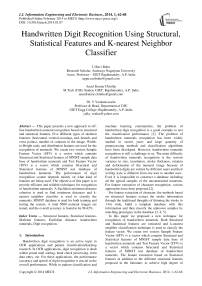Handwritten Digit Recognition Using Structural, Statistical Features and K-nearest Neighbor Classifier
Автор: U Ravi Babu, Aneel Kumar Chintha, Y Venkateswarlu
Журнал: International Journal of Information Engineering and Electronic Business(IJIEEB) @ijieeb
Статья в выпуске: 1 vol.6, 2014 года.
Бесплатный доступ
This paper presents a new approach to off-line handwritten numeral recognition based on structural and statistical features. Five different types of skeleton features: (horizontal, vertical crossings, end, branch, and cross points), number of contours in the image, Width-to-Height ratio, and distribution features are used for the recognition of numerals. We create two vectors Sample Feature Vector (SFV) is a vector which contains Structural and Statistical features of MNIST sample data base of handwritten numerals and Test Feature Vector (TFV) is a vector which contains Structural and Statistical features of MNIST test database of handwritten numerals. The performance of digit recognition system depends mainly on what kind of features are being used. The objective of this paper is to provide efficient and reliable techniques for recognition of handwritten numerals. A Euclidian minimum distance criterion is used to find minimum distances and k-nearest neighbor classifier is used to classify the numerals. MNIST database is used for both training and testing the system. A total 5000 numeral images are tested, and the overall accuracy is found to be 98.42%.
Structural features, Statistical features, Skeleton features, Euclidian distance, handwritten numerals, Digit recognition
Короткий адрес: https://sciup.org/15013237
IDR: 15013237
Список литературы Handwritten Digit Recognition Using Structural, Statistical Features and K-nearest Neighbor Classifier
- Y. LeCun, et al., Comparison of learning algorithms for handwritten digit recognition, in: F. Fogelman-Soule, P. Gallinari (Eds.), Proceedings of the International Conference on Artificial Neural Networks, Nanterre, France, 1995, pp. 53–60.
- O.D. Trier, A.K. Jain, T. Taxt, "Feature extraction methods for character recognition—a survey", Pattern Recognition 29 (4) (1996) 641–662.
- H.Nishida and S.Mori, "Algebraic description of curve structure", IEEE Tram actions on PAMI, V01.14, NO.5, pp.516-533, 1992.
- S.I.Abuhaiba and P.Ahnied, "A Fuzzy graph theoretic approach to recognize the Totally unconstrained handwritten numerals", Pattern Recognition, V01.26. No.9. pp. 1335- 1350, 1993.
- S.Mori and M.Doli, "A sequential tracking extraction of shape features and its constructive description", Corn part. Vision Image Processing. Vol. 19, pp.349-366, 1982.
- THE MNIST DATABASE of handwritten digits Yann LeCun, Courant Institute, NYU Corinna Cortes, Google Labs, New York.
- R.C.Gonzal, R.E.Woods, "Digital Image Processing", Pearson Education, 2002.
- O. Trier, A. Jain and T. Taxt, Feature extraction methods for character recognition: A survey, Pattern Recognition, 29(4), 1996, 641–662.
- Seong- W han Lee, "Multi layer cluster neural network for totally unconstrained handwritten numeral recognition. Neural Networks. Vo I. 8. No 5. pp.409-4 1 8, 1984.
- T. Y. ZHANG and C. Y. SUEN "A Fast Parallel Algorithm for Thinning Digital Patterns" Image Processing and Computer Vision, March 1984 Volume 27 Number 3.
- M W Chen and M H Ng " Recognition of Unconstrained Handwritten Numerals using crossing features" International conference ISSPA 99 Brisbane, Australia, 22-25 August, 2008.
- Gheith A, Abandah and Mohammed Z Khedher "Analysis of Handwritten Arabic letters Using Selected Feature Extraction Techniques" International Journal of Computer Processing of Languages Vol 22. No 1(2009) 1-25.
- Devinder Singh and Baljit Singh Khehra, "DIGIT RECOGNITION SYSTEM USING BACK PROPAGATION NEURAL NETWORK", International Journal of Computer Science and Communication- Vol. 2, No. 1, January-June 2011, pp. 197-205.
- QAMAR ABBAS , JAMIL AHMAD, WAQAS HAIDER BANGYAL, "Analysis of Learning Rate using BP Algorithm for Hand Written Digit Recognition Application", in IEEE -2010.


